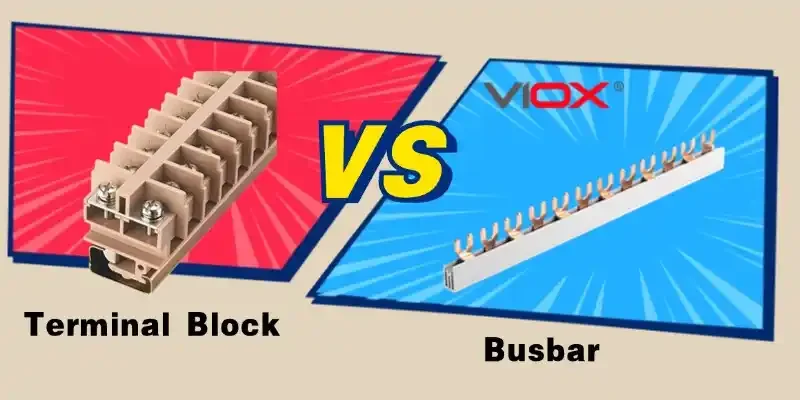Вступ
A. Огляд розподілу потужності в електричних системах
Розподіл електроенергії - важливий компонент електричних систем, який дозволяє ефективно передавати електричну енергію від джерел до різних навантажень. Щоб забезпечити продуктивність, безпеку та надійність, цей процес передбачає контроль потоку електроенергії через різні компоненти. Шинопроводи та клемні колодки є важливими частинами цієї системи, оскільки вони виконують різні функції в розподілі та організації електроенергії.
B. Важливість вибору правильного рішення
Правильний вибір рішення для розподілу електроенергії має важливе значення для максимізації продуктивності системи та гарантування безпеки. Вибір між клемними блоками і шинами може мати великий вплив на загальну ефективність, обслуговування і складність монтажу. Інженери та технічні фахівці можуть приймати обґрунтовані рішення, які підходять для конкретних застосувань, знаючи про їхні відмінності.
Розуміння шинопроводів
A. Визначення та основна концепція
У системах розподілу електроенергії, шини-Металеві смуги або шини використовуються для збору та транспортування електроенергії від вхідних фідерів до вихідних фідерів. Вони діють як координаційний центр, де кілька електричних з'єднань об'єднуються разом, що дозволяє ефективно регулювати величезні струмові навантаження. В електричних системах шинопроводи, які зазвичай складаються з провідних матеріалів, таких як мідь або алюміній, мають вирішальне значення для зниження опору і зменшення втрат електроенергії.
Додатковий відеоконтент для шинопроводів.
B. Основні характеристики шинопроводів
- Висока навантажувальна здатність: Шинопроводи ідеально підходять для важких умов експлуатації, оскільки вони витримують великі струми
- Низький опір: Завдяки міцній конструкції вони мають низький електричний опір, що знижує втрати енергії під час передачі.
- Компактний дизайн: Шини займають менше місця, ніж традиційні методи прокладки, що спрощує монтаж
- Ефективне відведення тепла: Конструкція забезпечує краще охолодження, запобігаючи перегріванню під час високих струмових навантажень
- Гнучкість: Вони можуть бути розташовані різними способами, щоб задовольнити різні потреби в розподілі електроенергії.
C. Як працюють шини
Зазвичай розміщені всередині розподільних пристроїв або щитів, шинопроводи слугують провідниками, які збирають електричну енергію від вхідних джерел і розподіляють її по декількох вихідних ланцюгах. Це дозволяє легко розгалужувати ланцюги в різних точках вздовж шинопроводу, а в разі несправності автоматичні вимикачі можуть відключити пошкоджену ділянку, забезпечуючи надійність системи.
D. Типи компонування збірних шин в енергосистемах
- Схема з однією шиною: Передбачає наявність однієї шини, підключеної до всього обладнання. Хоча така схема проста і не потребує технічного обслуговування, несправність впливає на все електроживлення.
- Розташування головної та передавальної шин: Використовує дві шини зі з'єднувачем для передачі навантаження між ними. Така схема забезпечує безперервність живлення під час технічного обслуговування або несправностей, але є більш дорогою.
- Подвійна шина з подвійним вимикачем: Має дві шини та два автоматичні вимикачі для підвищення надійності та гнучкості, забезпечуючи безперебійне живлення під час технічного обслуговування.
- Полуторне розташування вимикачів: Включає три автоматичні вимикачі для двох незалежних ланцюгів, що дозволяє легко додавати ланцюги, але з більшими витратами на обслуговування.
- Кільцева головна схема: Утворює замкнутий цикл, забезпечуючи надмірність; якщо одна секція виходить з ладу, система продовжує працювати через інший шлях, хоча це обмежує майбутнє розширення
Розуміння клемних блоків
A. Визначення та основна концепція
A клемна колодкаЗ'єднувальна клема, яку іноді називають з'єднувальною клемою або клемним з'єднувачем, - це модульна деталь, призначена для утримання двох або більше кабелів разом всередині ізольованої рамки. Ця збірка полегшує добре організовані закінчення проводів і з'єднання, пропонуючи надійний і легкодоступний метод управління електричними ланцюгами в різних умовах, особливо в панелях управління і електричних шафах.
Щоб побачити ці принципи в дії, ми рекомендуємо це інформативне відео на YouTube про техніку клемних колодок.
B. Як працюють клемні колодки
Принцип роботи клемних колодок полягає в тому, що вони забезпечують безпечне місце для з'єднання проводів. Кожна клема в колодці призначена для надійного утримання дроту в потрібному положенні; щоб гарантувати міцне з'єднання, іноді використовуються гвинти або затискачі. Проходження електрики або електричних сигналів між різними ланцюгами стає можливим завдяки затисканню, яке відбувається, коли дроти вставляються в клеми. Такий підхід підвищує безпеку, унеможливлюючи випадкові відключення, а також спрощує прокладку проводів.
C. Основні характеристики клемних колодок
- Модульна конструкція: Клемні блоки можна легко розширювати або модифікувати, додаючи або видаляючи клеми відповідно до вимог.
- Ізоляція: Ізоляційний корпус захищає від випадкового контакту з проводами, що знаходяться під напругою, підвищуючи безпеку.
- Варіанти монтажу: Багато клемних блоків призначені для монтажу на DIN-рейку, що дозволяє легко встановлювати і організовувати їх в електричних панелях.
- Універсальність: Підходять для різних розмірів і типів дроту, що робить їх придатними для різноманітних застосувань.
- Легкий доступ: Завдяки впорядкованому розташуванню клемних блоків спрощується пошук і усунення несправностей та технічне обслуговування
D. Типи клемних колодок
- Однорівнева прохідна клемна колодка: З'єднує два дроти разом для простого з'єднання між собою.
- Дворівнева клемна колодка: Дворівневі клеми заощаджують простір, дозволяючи здійснювати кілька з'єднань.
- Багаторівнева клемна колодка: Пропонує три або більше рівнів для ще більшої кількості з'єднань у компактній формі.
- Клемна колодка заземлення: Спеціально розроблена для з'єднання проводів із заземленням, забезпечуючи безпеку та відповідність електричним стандартам.
- Клемна колодка з запобіжником: Містить запобіжник всередині блоку для забезпечення захисту від перевантаження по струму без використання зовнішніх запобіжників.
- Вставна клемна колодка: Дозволяє легко вставляти дроти без інструментів; часто вимагає наявності наконечників для надійного з'єднання.
- З'єднувач зі зміщенням ізоляції (IDC): З'єднує дроти без зняття ізоляції; гострі леза прорізають ізоляцію для встановлення контакту.
- З'єднувальна клемна колодка: Має конструкцію типу "вилка-розетка" для швидкого від'єднання, що корисно в додатках, які потребують частого обслуговування
Порівняння: Шини проти клемних колодок
A. Можливості керування потужністю
- Шинопроводи: шинопроводи призначені для передачі великих струмів, і завдяки своїй міцній конструкції та низькому опору вони можуть ефективно справлятися з великими силовими навантаженнями. Зазвичай вони використовуються у важких умовах експлуатації, де вони можуть витримувати великі струми з невеликим падінням напруги, наприклад, на підстанціях і промислових машинах.
- Клемні колодки: Хоча клемні колодки можуть приймати широкий діапазон розмірів і типів проводів, їхня середня пропускна здатність нижча, ніж у шин. Вони добре працюють в невеликих системах, де необхідна акуратна проводка, але можуть бути не найкращим вибором для розподілу великої потужності.
B. Вимоги до простору
- Шинопроводи: ці деталі забезпечують компактний варіант розподілу електроенергії, дозволяючи здійснювати кілька з'єднань на невеликій площі. Завдяки своїй конструкції вони вимагають менш розгалуженої проводки, що економить простір, коли мова йде про електричні панелі.
- Клемні блоки: Оскільки клемні колодки є модульними, з окремими клемами, вони займають більше фізичного простору. У порівнянні з шинами, це може призвести до більш громіздкої установки, особливо в додатках з великою кількістю з'єднань.
C. Гнучкість та модульність
- Шинопроводи: Шинопроводи - це надійний спосіб розподілу живлення, але після встановлення вони гірше піддаються модифікації, ніж клемні колодки. Додати або видалити з'єднання може бути складніше.
- Клемні колодки: Модульність і гнучкість клемних колодок є чудовими. Додавання або видалення клем дозволяє легко розширити або модифікувати їх, що робить їх ідеальними для додатків, які потребують частої заміни або усунення несправностей.
D. Міркування щодо витрат
- Шинопроводи: оскільки вони вимагають спеціального монтажу і мають вищі ціни на матеріали, шинопроводи часто можуть бути дорожчими на початковому етапі. Але з часом ці початкові витрати можуть бути зменшені завдяки їх довговічності та ефективності у високопотужних системах.
- Клемні блоки: Клемні колодки, як правило, є більш економічним варіантом, ніж шини, коли мова йде про невеликі інсталяції. Їх менша початкова вартість робить їх бажаними для проектів з обмеженим фінансуванням, але якщо потрібні регулярні налаштування, вони можуть призвести до збільшення витрат на обслуговування.
E. Придатність для різних застосувань
- Шинопроводи: ідеально підходять для сильнострумових застосувань, де ефективність і надійність мають вирішальне значення, наприклад, для розподілу електроенергії в промислових умовах, системах відновлюваної енергетики та електричних підстанціях.
- Клемні колодки: Ідеально підходять для панелей керування, монтажних з'єднань і невеликих електричних систем, де цінується організованість і простота доступу. Вони широко використовуються в умовах, що потребують регулярних налаштувань або усунення несправностей
| Особливість | Шини | Клеммники |
|---|---|---|
| Дизайн | Суцільний шматок металу | Сегментований з окремими терміналами |
| Тип схеми | Один контур для декількох з'єднань | Кілька незалежних контурів |
| Поточна потужність | Висока струмова ємність з низьким опором | Менша струмова потужність на одну клему |
| Встановлення | Компактний і простий у використанні | Потребує більше місця через окремі термінали |
| Відведення тепла | Ефективний завдяки міцній конструкції | Обмежена; залежить від потоку повітря навколо терміналів |
Висновок
Отже, і шинні збірки, і клемні колодки відіграють важливу роль в системах розподілу електроенергії, кожна з яких має свої унікальні переваги та сфери застосування. Шинопроводи ідеально підходять для сильнострумових промислових установок, де ефективність використання простору і розсіювання тепла є критично важливими. Вони пропонують надійне рішення для великомасштабних потреб розподілу електроенергії. З іншого боку, клемні колодки є кращим рішенням у сценаріях, що вимагають частих модифікацій, легкого доступу для обслуговування та організації декількох менших ланцюгів. Вибір між цими двома варіантами залежить від таких факторів, як поточні вимоги до потужності, обмеження простору, потреби в гнучкості та бюджетні міркування. Розуміння цих відмінностей дозволяє інженерам і технічним фахівцям приймати обґрунтовані рішення, забезпечуючи оптимальну продуктивність, безпеку та ефективність електричних систем. Зрештою, правильний вибір між шинопроводами та клемними колодками може суттєво вплинути на загальну надійність та ефективність системи розподілу електроенергії.
Посилання
https://en.wikipedia.org/wiki/Busbar
https://www.reddit.com/




